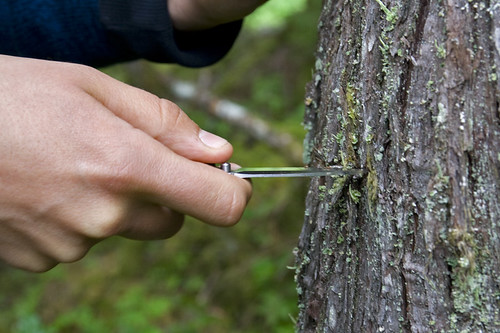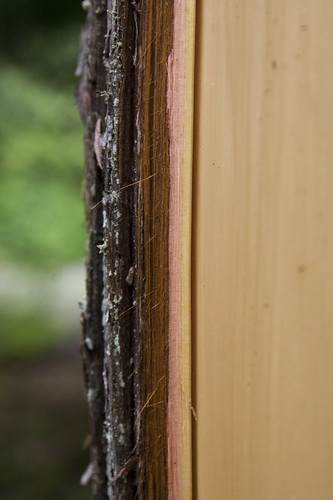
first up, we found a suitable tree, a western red cedar, and then made a little offering and thanked the tree for sharing with us. then she made the first cut. we made a cut horizontally across a section of bark, and then a vertical slice on each side until we could pry up a section to grab hold of.

then we pulled up and the bark released along a length of the trunk until it came free. we pulled off several thin sections with a bit of work, although the bark does come off fairly easily in this way.

above you can see a cross section of the tree, showing the inner bark between the rough outer bark and the smooth wood of the tree. after pulling the bark from the tree, we thanked the tree again, and began on the next step. we peeled the desired inner layer from the outer bark. then we put the inner bark in a tub of water to soak and soften.

after the bark has softened, it often needs further work by making thinner strips that are easier to work with. Em then taught me to make basic cordage, which can be used for a variety of things but makes great bracelets and necklaces. but i still have a fair bit of cedar left, so i am doing some further research on weaving. perhaps eventually i will be able to make a hat like this.

the peoples of the pacific northwest traditionally use cedar for a variety of items including clothing and hats. if you are interested in a comprehensive look at how cedar plays a part in the first nations cultures of the coast, hilary stewart's book cedar is a wonderful resource. i am also hoping to perhaps incorporate some of the cedar into my stitch work; i would love to bring a bit more of the coast into my work this way.



8 comments:
oh my heart. those braids in the last photo are so amazing!
Fantastic. I love seeing traditional crafts. an't wait to see how you use it in your work. The results I am imagining in my head are so interesting!
Wow, that is really cool. I've seen the harvesting, but not the braids like that next to the raw product. Thanks for the photos.
this is such a nice idea! unfortunately there are no forests in israel (nothing that i would call a forest at least) so i wont be able to try this... but i am really looking forward to see where you are going with this =)
Interesting post, k. I liked seeing the process and the braids are very cool. I can't imagine how you are going to use the bark in your stitching so I can't wait to see what you have in mind. Stitched bark on fabric would have such great texture.
fascinating! One more thing I've never seen...
so very interesting
i think there is a section about this in a book i have saved for summer reading
lost crafts by una mcgovern
Thanks for sharing...this process is fascinating. I've seen some of the finished products of course, but never the process. And I'm very interested in seeing where you take this...
Post a Comment